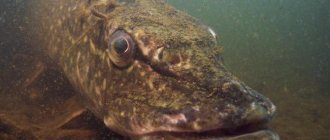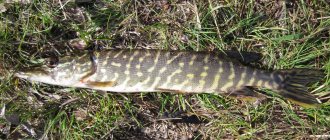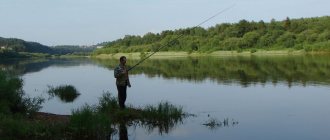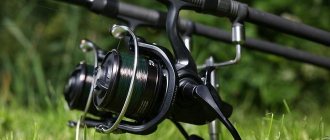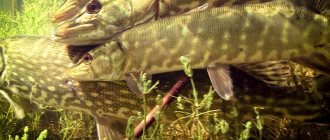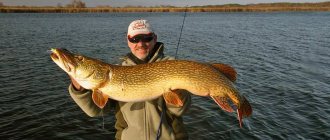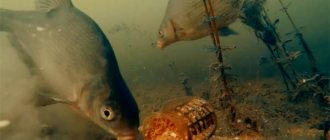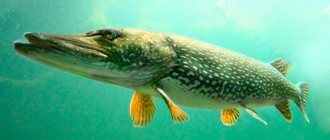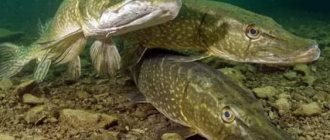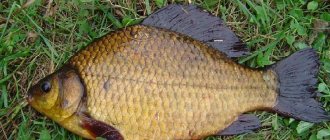Catching pike with dead fish in winter
Background
One day our fishing company went to one of the paid reservoirs, especially for ice fishing for pike. Having arrived at the place, we learned that we couldn’t buy live bait here—we had run out. Then it was decided to purchase at least dead fish at the market. The choice in winter was very limited. Having bought horse mackerel as the smallest fish available for sale, we asked the seller to select 0.5 kg of only small things for us.
Half an hour later we were already walking on the slightly powdery blue ice that was falling off. It was cloudy, but not cold. We walked between thickets of dry reeds and stopped at a previously checked place. Having equipped the girders with horse mackerel, they began to unwind the fishing rods.
Time passed, but there were still no normal bites. Occasionally there were pike stretches, but the pike preferred to quickly spit out the dead sea fish, sensing a catch, and fishing with artificial ones did not bring any results.
Start of fishing
Then my comrade, Victor, decided to put the horse mackerel on a light jig head. And in one place, in less than an hour, I managed to pull out 7 pikes, up to a kilogram each. We, of course, followed his example and were also not left without a catch. Fishing for pike with dead fish brought us 5 times more pike than the zherlitsa. Accident? Don't think!
Secret: on girders, a dead fish hangs motionless in the water column and attracts little pike, but when played with a jig head, this bait moves as if it were alive and provokes the predator to grab it.
Collecting fishing gear
There are some requirements for a dead fish rig:
- possibility of throwing at 20−30 m;
- the bait (i.e. dead fish) should sink easily and take a natural position at the bottom;
- have a service life of at least 20 casts, and preferably at least 50;
- easy to make with your own hands.
To create such a tackle for pike, you need the following materials and tools:
- wire that bends with difficulty;
- can lid;
- fishing hooks in the form of tees (2 pcs.);
- carbine;
- beads;
- sinker;
- Styrofoam;
- black marker.
Having prepared the necessary tools and materials, you can proceed to making a tackle for a dead fish. The sequence of actions is as follows:
- Cut a piece 10 cm long from the wire. At one end of it, make a ring, onto which you hook a carabiner, and then a tee.
- Pass the second tee through the ring of the hook, and then wrap it with wire several times. After this, put on the bead.
- From the lid, cut out a part that resembles a propeller, but of very small size. Make a hole in the center for the wire, pass it through the propeller, and then secure with a second bead.
- Now you need to make a ring, onto which you can later hook the sinker and leash. But before this, the sinker must be secured to a separate piece of wire, which is placed behind the second bead and in front of the tee.
The effectiveness of catching dead fish also depends on the choice of fishing rod; the equipment must be carried out according to the rules:
- For sharp anchors, a flexible rod with a medium action is suitable;
- for fishing in reservoirs without a current, it should be as rigid as possible;
- when on the shore, it is better to take a long rod (about 3-4 m);
- durable, have a weight test of at least 80 g.
Now you can choose bait for your tackle. To catch large pike with dead fish in winter, both freshwater and sea dead bait can be used as bait. But the second option is preferable, since such bait is more affordable. In addition, sea fish have a high fat content, which means they are more attractive to pike in winter. This predator loves herring and mackerel.
It is recommended to use them whole for fishing, which is why you need to buy whole carcasses. It must be remembered that the weight of the bait must correspond to the weight of the intended victim. For large predators, you can use bait weighing at least 200 g. If such specimens are not found in a reservoir, then there is no point in taking such carcasses. The average pike simply cannot take them.
Attention should also be paid to the length of the carcass. It should not exceed 15 cm.
In addition to herring and mackerel, other representatives of marine aquatic fauna are also in demand:
- sardine;
- sprat;
- horse mackerel;
- gerbil;
- garfish;
- mullet;
- whiting.
Any freshwater fish can be used to catch pike. But fishermen prefer roach, rudd and eel pieces.
You can buy bait in specialized stores. It is sold frozen, but the quality does not suffer from this.
Tackle for catching pike with dead fish in winter
You will need a winter rod for vertical trolling. A guard (nod) is not required. According to many anglers who are keen on this kind of fishing, it will even interfere, since it will not allow them to make a timely hook to break through the mouth of the pike.
The main line used is a fishing line with a diameter of 0.3 mm. Of course, an elastic leash is required, to which a jig head weighing from 3 to 20 grams is attached, depending on the size of the bait and the fishing depth.
Why is an elastic leash required?! The game of a dead fish should be more lively, which will therefore attract the pike more.
Methods of attaching fish and equipment features
To catch a trophy pike with a dead fish, you need to choose the right bait. Perch and roach are considered catchable options, and some anglers prefer herring. The size of the fish must correspond to the expected catch - for trophy pike there is no point in using bait weighing less than 200 grams. If there is no large predator in the reservoir, the bait should be selected in proportion to the size of the pike in a particular reservoir.
Using a bait needle, a metal leash is passed under the skin of the fish, to which 2 or 3 treble hooks are attached, which are fixed in the bait with one sting for reliable fixation. This design ensures reliable hooking and also prevents the pike from biting the main line.
Tackle game
Playing with the tackle is extremely simple: you need to lower the fish to the bottom, lift it slightly and make sweeping strokes of the rod up and down with pauses between them. The amplitude and frequency of the strokes are determined experimentally. First, you need to make wider strokes to attract the attention of the fish, and if there are no bites, then reduce their amplitude or change the pause time. If fishing is carried out at significant depths, then different layers of water should be fished.
It’s quite easy to feel a pike bite. You feel a sharp blow transmitted through the rod into your hand. You need to hook it right away - this is not fishing with live bait, when the pike needs to be given time to swallow it. If a large predator is caught, then it can even snatch the rod out of your hands, so be always on alert. When fishing, it is better not to hesitate, since it is not a fact that the fish is well spotted.
The example with horse mackerel was, of course, simply illustrative. In fact, the pike should more boldly take on fish that are natural to its habitat - crucian carp, roach, bleak, etc.
Shelter and hidden hunting of pike
The most common statement about pike is that it is a predator that leads a sedentary lifestyle and prefers to hunt from cover. And, therefore, you can meet a toothy one where there are such shelters. The first thing that comes to mind: aquatic vegetation and snags. These are the places that were first on the list of places I visited. Although, they are not available everywhere. And we can add: not everywhere where there is shelter, there is a pike, just as not everywhere where there is a pike, there is shelter.
In truth, this predator, like any other, adapts well to conditions.
But if, for example, you rarely see a chub outside its traditional places, then the pike is much more mobile. The main goal of the toothy one is, of course, food supply. Practice shows that pike can hunt in the water column at an actual depth of 10, 20 or more meters. I know of at least three cases of catching pike weighing more than 9 kg at a depth of 7–10 meters with an actual depth of about 50. Obviously, there are no natural or artificial shelters in such a place.
Many stereotypes are confirmed in practice, but in most cases there will always be an alternative path to success.
The pike probably uses its color as a camouflage much more than its environment. Otherwise, how can such differences in the color of the toothy be explained? Including the overall color. Actually, the tactics of vertical jigging largely rely on this: searching for places where small fish accumulate and where a large predator stands next to them.
Therefore, here is my main advice: under no circumstances get hung up on certain places. Remember that throughout the year processes occur in the aquatic environment that radically change the living conditions of fish. Absolutely all fish are in constant motion. Most often, catching a trophy depends on the right fishing location. In any case, this applies to a greater extent to pike, which, unlike other species, is still less attentive to the bait.
Finding places to catch dead fish in winter
If all the tricks did not lead to bites, then feel free to move to another place. Glades or channels between dry reeds or reeds are considered very promising.
When searching for pike in a pond, you should make at least 10 holes in a row a few meters apart in the most promising places and fish them one by one. If there is no bite on one hole, you should not linger on it for more than 5 minutes.
Installation of a diverter leash for catching perch
Catching roach in November with a float rod >>
Features of fishing tactics
First of all, you should decide on the “pike” places on a particular river, since if you fish anywhere, even the attractive smell of the bait may not save you from zero. The most promising points depend on the season, but often these are the growth line of reeds, various holes at the bottom, especially with snags, and channel edges. It is worth throwing the fish at such points.
When actively fishing with a spinning rod, the approach to choosing points is approximately the same, only in this case the possibilities of experimenting with wiring open up. From faster and more aggressive options when pike are highly active, to slow retrieves with long pauses when the predator is passive.
Fishing for pike with a tackle will be discussed in the video:
Installation of equipment for pike perch
The easiest way to fish in still water is with a float tackle. In this case, there are no problems with installing the fish. You just need to measure the depth at the fishing point and fix the float at the required distance.
Thus, the bait will always be supplied at the required distance from the surface of the water. If you are fishing for pike perch in the current, then you cannot do without a heavy weight. There will be no problems with delivering a piece of fish to the bottom.
But how can you make a whole fish float to the required distance?
For these purposes, a floating element is introduced into the body of the bait. This could be a piece of foam or other highly buoyant material. The easiest way to administer it is through the mouth, after making the surface of the material smooth.
In this case, the resistance when inserted into the fish will be minimal. At the required distance from the hook (20-30 cm), you need to place a rubber stopper and a bead to slow down the sliding weight.
The line will pass through it without the slightest resistance, which is very important when catching a cautious predator.
Bait and bait are different
When going to an unfamiliar body of water at different times of winter, the fisherman must designate the search area for pike depending on the characteristics of its behavior.
And here’s what you need to know: Buy a spinning rod in a large online store with delivery throughout Moscow, Russia and Kazakhstan
It is impossible to know the place where pike will be caught, but it is not difficult to predict where it will definitely not be:
- near concentrations of small fish and freshwater vegetation, since it often lives at great depths;
- near bottom irregularities, for example, on the banks of an old channel, in the depressions of the banks and in their protrusions;
- in obstructions and behind obstacles, for example, next to fallen trees, in depressions and elevations.
The bait can be stored frozen. To do this, it needs to be packed in plastic bags, preferably individually or in small groups. One package - one bait. Both sea and freshwater fish can be stored in this form.
Over the years of fishing, anglers have developed a large number of methods for catching pike in winter. Each of them has its own characteristics and any fisherman can choose the most suitable one, focusing on the characteristics of the reservoir and his skills.
Fishing with girders
Catching pike with girders in winter (or, as they also say, with flags) is one of the most popular methods. The zherlitsa consists of:
- round stand or short wooden pole;
- bracket;
- coil;
- latch with flag;
- fishing line with a diameter of 0.3 mm and a length of 12-15 meters;
- tungsten leader;
- sinker;
- hook - double or triple.
Live bait is used as a bait:
- gudgeon;
- small perch;
- small roach;
- ruff.
A few words about the bait itself. A dead fish, of course, does not mean that it has been lying there for several days! Only fresh or, as a last resort, frozen! To fish using this method you will need from 15 to 20 fish.
The best bait for pike perch is bleak, but in this case, it is not as effective as, for example, perches or brushes, since it flies off after several casts! Carpenter is also a good choice for this method.
Now about the size of the bait. In the summer, when the water column warms up quite well, it is best to catch fanged fish with a whole fish, and its size directly depends on the climatic conditions of each month:
- July and August - as a rule, during these months, the water warms up to its maximum depth, and the fry frolic in huge numbers in the shallow water! During this period, it is recommended to use small bait - 2 - 3 centimeters long. Even with this size of bait, you can catch a trophy specimen.
- September, May and June are the months when a longer bait with a narrow body is used. Size – up to 10 centimeters.
- In October, when the water has already cooled down and the pike perch is preparing for winter, without making unnecessary movements, saving the energy accumulated over the summer, it is very effective to use not whole fish, but its pieces. In addition, such pieces emit a stronger odor, which drives the pike perch into a frenzy and, confident of an easy profit, it attacks!
Also, you should take into account the depth of the bait. A whole fish, as a rule, sinks to a depth of 20 - 30 centimeters from the bottom. Pieces must be served at the very bottom!
Also, the gear for catching pike perch has some differences. They depend directly on the condition of the reservoir.
And here's what you need to know: Catching perch with a balance beam. Catching large perch in winter!
Pike fishing tactics in winter
First of all, when going ice fishing, you need to take care of preparing not only gear, but also good quality clothing and tools.
Preparing for winter fishing
When going to a pond, be sure to check:
- Condition of clothes and shoes. It should be warm, but not restrict movement.
- In severe frosts, you can take a tent in which you can easily warm up the air using a gas stove or simple dry fuel.
- Check the condition of the gear, replace the leashes damaged by pike teeth, check the sharpness of the hooks; it is better to replace blunt ones at home, rather than get nervous when a pike escapes. Scaffolding quickly breaks down in the cold; it is often not enough for 1 season, so pay attention to this.
- Be sure to check the condition of the nods and fishing rods, replace damaged parts or the entire fishing rod. On the vents, check the ease of rotation of the coil and the integrity of the guard.
- It is necessary to check the box with lures; often when fishing, damaged baits are placed here, which should be replaced. It is better to take spoons and jigs with a reserve.
- Check the sharpness of the ice auger blades and the general condition of this indispensable tool. When going out on the ice, it is better to have a spare set of sharpened knives, especially if you are fishing with girders.
- The hook on the handle is an indispensable means of securing the prey and preventing the line from tearing when the fish touches the edge of the hole.
- An extractor and yawner will help remove the pike from the hook.
Seasonal fishing features
On the first ice you have to catch pike at depths of up to 1 m, so there is no point in using deep-sea heavy spoons. The bait should immediately begin to play, even when immersed, attracting pike over long distances. It is recommended to install several girders at half-water; in this case, the pike will see the moving fish at a distance and approach the baitfish.
If there are no bites when moving the spoon, try raising the bait higher, this will help the pike approach the spoon faster. Wild winter - at this time, fishing with girders is preferable, but a fishing rod with a supply of spinners can also come in handy. At this time, it is better to go fishing during the thaw. In severe frosts, pike stay in wintering pits with a high oxygen content in the water.
In the dead of winter, you can try to tease a predator by lowering a trap with a piece of frozen fish treated with blood. The last ice is fished using all types of gear. Pike become active after winter hibernation and rush to any tackle.
Important! When going fishing on the first or last ice, do not forget about your safety. Be sure to have a length of rope ready and don’t go out on thin ice alone. If you fail, immediately throw your arms wide to the sides and call your friends for help.
Fishing secrets from experienced fishermen
Don't forget about camouflage, especially when fishing for pike at shallow depths. Don't wear bright colors or be noisy on the ice. When drilling holes, you should not remove slush by lifting an ice drill, “pumping” the hole.
This creates a lot of noise and vibrations in the water. All attractive places are immediately marked and holes are made in the ice. The distance between the holes should be 7–10 m. It is better to make several extra holes in different places, here you can catch pike. All this work is done before 9 am. The pike becomes active after this time and goes hunting. The biting period in winter is short. Often it lasts only 2–3 hours.
If you fish with vertical spoons, fishing is carried out according to the following algorithm:
- The spoon sank to the bottom.
- By making several short jerks, achieve the formation of a cloud of turbidity.
- Slowly raise the fishing rod 300–400 mm from the bottom. At this time, the spinner makes oscillatory movements.
- Lower the fishing rod to the ice, allowing the spoon to sink to the bottom. During this period, pike attacks often occur, so watch the behavior of the tackle and don’t miss the attack.
In this way, perform 3-4 cycles, if there are no attacks, raise the bait to half-water and repeat the cycle again.
When fishing with tube spinners, jig heads or rattlins, the style of fishing changes. You will need to perform sharp lifts of the fishing rod and alternate them with lifting the bait, with tapping on the fishing rod while lifting the wobbler.
When fishing with girders, be sure to use a special thermos to preserve live bait, which can be caught in advance or early in the morning using a jig. You should not lower the tackle into the hole; it is better to place it on the edge. When triggering, pay attention to the amount of line on the reel.
If it is wound up, it means the predator is holding bait in its mouth. If the reel does not rotate and the line is not reeled in, it could be triggered by an idle bite from a missed pike or from a jerk of a large baitfish. When starting fishing, first take all the poles to the holes - and only then begin to alternately attach live bait and alert the tackle.
Place the bait at a distance of 100–300 mm from the bottom, the pike will see the prey faster and attack it. Be sure to cover the hole with snow or ice chips and do not clear it when fishing for pike to prevent light from entering the hole.
Follow all the recommendations and instructions, gain experience, and fishing happiness will definitely bring you a decent catch of large pike, with which you won’t be ashamed to take a photo. Happy fishing!
Donka with live bait - features
You can not only use a camp-type donka for fishing with dead fish, but also fish with such a donka with live bait. To do this you will need an ordinary large float. A small plastic bottle with a capacity of 0.25-0.33 liters will also work. This bottle will keep all the tackle floating and will prevent baitfish from burying themselves in the mud.
When fishing for pike on the bottom, you can attach live bait like this.
To prevent the tackle from being carried away by the current, make two sinkers. The first sinker prevents the bait from floating, holding it at a given depth. The second sinker is heavy and serves as an anchor, which holds all the gear in the current, preventing it from floating away with the current.
This is why such a large volume float is required. Sometimes, in order to keep the tackle in the current, you have to use a stone instead of the bottom heavy sinker. Then it is attached to the tackle with such a fishing line that it can withstand a smooth cast, but that it breaks off during a sharp hook.
In this case, the bite will be indicated at the moment the pike grabs and at the moment it tries to escape with live bait in its mouth. You will see this in the behavior of the float.
For bottom fishing with live bait, they usually use one tee, one hook of which is used to pierce the live bait just below the dorsal fin, trying to cause minimal damage to the fish.
If the live bait is small, then a small tee is used. It often happens that, having been tired for the day, no one is watching the donka. But the next morning, a decent-sized pike comes ashore, which calmly stands, having swallowed a tee, right under the shore.
When the bite happens at night, you can get a tackle with pike in the morning.
Naturally, in such cases you need to securely tie the spinning rod to an anchor on the shore. For a good pike can easily drag even heavy gear into the water, where it will most likely die.
More on this topic on our website:
- Pike in July - we catch it with spinning rods, donka and circles. July in all regions of the country is the warmest month. The water in July warms up to 25-28 degrees Celsius,…
- Fishing for pike in the summer with a spinning rod - looking for it, catching it With the beginning of the spinning season, when in mid-June anglers can again go out on the water in boats, normal pike fishing begins...
- Heavy jig for pike: catching a trophy In order to understand what a heavy jig is and how to use a heavy jig for pike, just watch the actions of a small…
- Pike in June - fishing with a spinning rod Well, the spawning ban is coming to an end, it’s time to take out the gear that was put aside and start catching pike in June...
